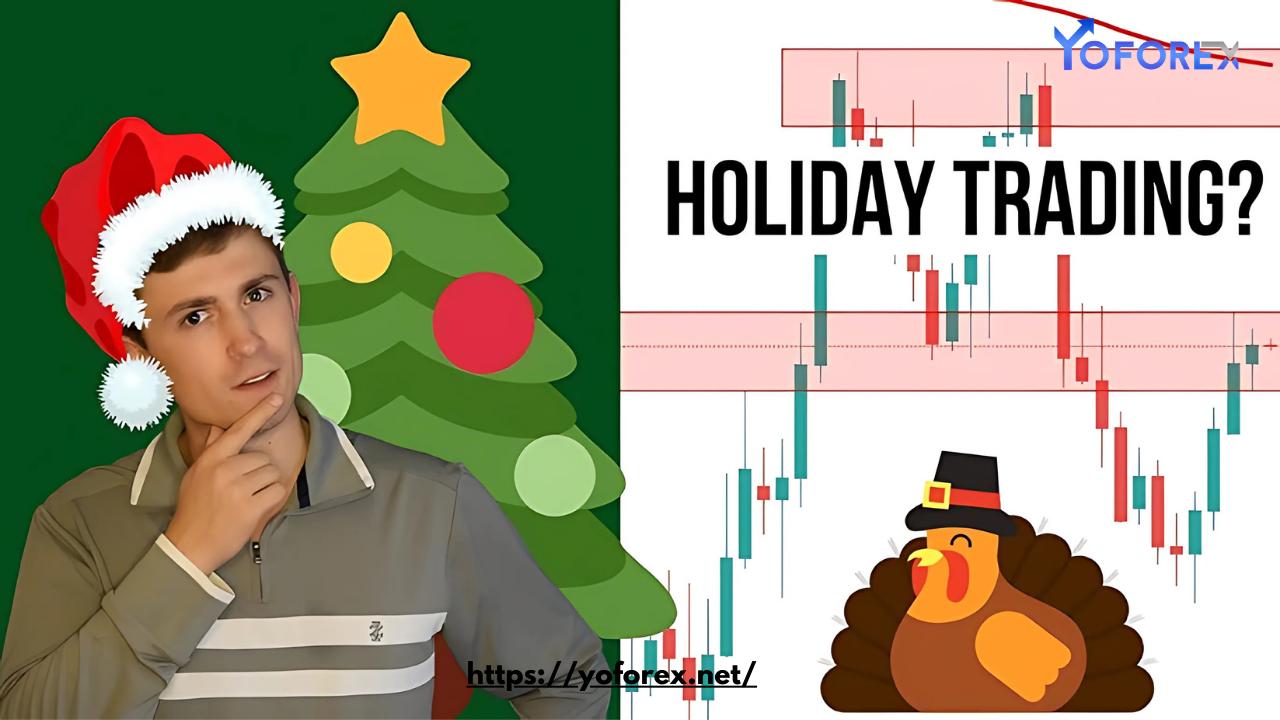The forex market operates 24 hours a day, five days a week, making it one of the most accessible markets in the world. However, during the holiday season, the market dynamics shift significantly. Reduced trading volumes, increased volatility, and changes in liquidity create unique challenges and opportunities for traders. This blog explores the key challenges of trading forex during holidays and strategies to navigate these periods effectively.
Challenges of Trading Forex During Holiday Seasons
1. Reduced Liquidity
- During holidays, major financial centers may close or operate with limited hours, leading to reduced market participation.
- Lower liquidity means fewer buyers and sellers, making it harder to execute trades at desired prices.
- Impact: Wider spreads and increased slippage can raise trading costs.
2. Increased Volatility
- With fewer participants in the market, price movements can become erratic and unpredictable.
- Large orders from institutions or unexpected news can cause sharp price swings.
- Example: Thin trading volumes during the Christmas season often lead to exaggerated market reactions to minor events.

3. Market Gaps
- Holiday periods often result in extended trading breaks, increasing the likelihood of market gaps when trading resumes.
- Gaps can lead to significant losses for traders holding positions over the holidays.
4. Unpredictable Market Behavior
- Normal trading patterns may not apply during holidays, as fewer institutional players participate.
- Retail traders and algorithmic traders can dominate, leading to irregular price movements.
5. Global Holiday Mismatches
- Different countries observe holidays at different times, causing variations in trading activity across currency pairs.
- Example: A holiday in Japan might reduce activity in JPY pairs, while USD pairs continue trading actively.
Opportunities in Holiday Trading
Despite the challenges, holiday seasons can present unique opportunities for forex traders:
1. Seasonal Trends
- Certain currencies exhibit predictable patterns during holidays, such as increased demand for USD during the year-end tax season.
- Example: The “Santa Claus Rally” in equities often influences correlated forex markets.
2. Volatility-Based Strategies
- Increased volatility can benefit traders using strategies like breakout trading.
- Example: Identifying key support and resistance levels before the holiday can set up profitable trades during sudden price spikes.
3. Scalping Opportunities
- Thin liquidity often creates rapid price fluctuations, providing opportunities for short-term scalping strategies.
4. Preparation for New Year Trends
- The end of the year often marks portfolio adjustments by institutions, which can influence currency trends heading into the new year.
Strategies for Trading Forex During Holiday Seasons
To navigate the unique challenges of holiday trading, traders should adopt tailored strategies:
1. Adjust Position Sizes
- Reduce position sizes to account for increased volatility and unpredictability.
- Smaller trades limit potential losses in case of sudden market moves.
2. Focus on Major Pairs
- Stick to major currency pairs (e.g., EUR/USD, USD/JPY), which tend to have better liquidity even during holidays.
- Avoid exotic pairs, as they often experience higher spreads and slippage.
3. Use Limit Orders
- Avoid market orders to prevent unfavorable fills during periods of thin liquidity.
- Set limit orders to ensure trades execute only at desired price levels.
4. Monitor Economic Calendars
- Pay attention to holiday schedules and economic events that may impact trading activity.
- Example: Central bank announcements or employment data releases during holiday weeks can create significant market movements.
5. Avoid Holding Positions Over Long Breaks
- Close open positions before extended holiday periods to avoid exposure to market gaps.
- If holding positions, ensure stop-loss and take-profit levels are in place.
6. Implement Volatility Indicators
- Use tools like the Average True Range (ATR) to gauge volatility and adjust trading strategies accordingly.
7. Focus on Technical Analysis
- With reduced market participation, technical analysis often holds more weight during holidays.
- Identify key levels, such as support, resistance, and trendlines, to plan trades.
Risk Management During Holiday Trading
Effective risk management is crucial during holiday periods to protect your account from sudden losses:
1. Use Wider Stop-Loss Levels
- Adjust stop-loss levels to account for increased volatility while maintaining a reasonable risk-reward ratio.
2. Diversify Trades
- Spread exposure across multiple currency pairs to reduce the impact of a single market-moving event.
3. Set Realistic Expectations
- Avoid overtrading and focus on preserving capital rather than chasing profits.
4. Maintain a Trading Journal
- Document holiday trades to identify patterns and improve strategies for future holiday seasons.
Case Study: Holiday Trading in Action
Scenario: A trader observes that EUR/USD exhibits increased volatility during the week between Christmas and New Year due to thin liquidity.
Strategy:
- Identifies key resistance at 1.1400 and support at 1.1300.
- Place a breakout order to buy above 1.1405 and sell below 1.1295.
- Uses a smaller position size and sets stop-loss orders to limit risk.
Outcome: The pair breaks resistance, moving to 1.1450, and the trader locks in profits by trailing the stop-loss level.
Tools for Holiday Forex Trading
- Economic Calendars:
- Track global holidays and market closures.
- Volatility Indicators:
- Use ATR and Bollinger Bands to measure price fluctuations.
- Trading Platforms:
- Utilize platforms with advanced order types, such as limit and conditional orders.
- News Feeds:
- Stay updated with real-time news to anticipate market-moving events.
Conclusion
Trading forex during the holiday season comes with unique challenges, including reduced liquidity, increased volatility, and market gaps. However, with proper preparation, risk management, and strategic adjustments, traders can navigate these periods successfully and even capitalize on opportunities. By understanding holiday market dynamics and adopting tailored strategies, you can turn potential pitfalls into profitable trading experiences. Remember, patience and discipline are key to thriving in holiday trading environments.
Stay Updated & Download: https://yoforex.net/trading-forex-during-holiday-seasons/

